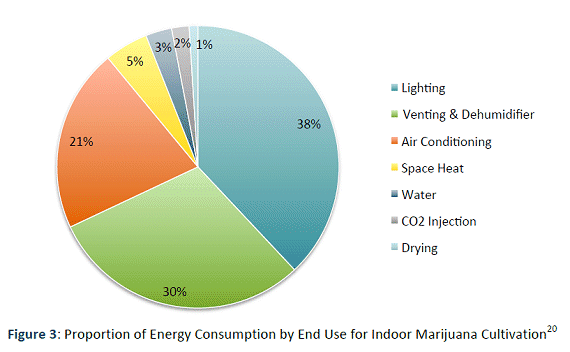A new white paper examines the challenge of energy consumption in the legal marijuana industry and offers some recommendations; based on a collaborative approach.
As we’ve mentioned in the past, the amount of energy being consumed by the cannabis industry in the USA is quite staggering – one estimate puts it at 1% of the nation’s electricity consumption.
While outdoor grows of industrial hemp tend to be quite energy efficient as nature supplies much of it, it’s the indoor medical cannabis growing operations that are the power-hungry culprits.

The energy cost component can account for as much as half of the wholesale price of marijuana.
Some switched on growers are making energy efficiency changes, including the use solar power. This is helping to reduce overall costs and boost profit margins – but awareness doesn’t appear to be all that great across the industry as yet.
According to policy research firm EQ Research, several barriers are preventing the industry from investing in energy efficiency and renewable energy.
- Power utilities and Public Utility Commissions lack information about how the marijuana industry consumes energy.
- The high cost of capital for cannabis businesses and lack of other financial support.
- While better energy practices may benefit business owners, growers are under pressure to maintain output and potency.
The white paper offers a series of recommendations to utilities, the public utility commissions, state and local governments and marijuana business associations; including
- Ensure growers are aware how much energy they are using, when they are using it, and when it is most expensive to consume it.
- Tailor energy efficiency rebates and services to marijuana growers.
- Design electricity rates to encourage efficient energy use within grow facilities.
- Create more equitable policies for connecting grow facilities to the mains grid and assessing costs for electricity infrastructure upgrades.
- Public Utility Commissions should set appropriate policy direction.
- At a state and local government level; zoning, building, and electrical codes should encourage clean energy, marijuana industry working groups should be convened, finance opportunities need to be provided and any rules that may be blocking energy efficiency be revised.
- Marijuana industry associations and entities need to invest in energy management, support related research, engage at public utility commissions and work with utilities in providing energy consumption information.
Each of these recommendations is explained in more detail in the white paper; “A Chronic Problem: Taming Energy Costs and Impacts from Marijuana Cultivation,” which can be downloaded here.
The paper’s authors also point out that all the bodies mentioned above need to work together. “Because the marijuana industry is in its nascent stages in the U.S., making this a coordinated effort could go a long way
to turning this ‘green’ industry into a truly verdant one,” they state.


